Financial Systems and Auditing Report: Detailed Analysis and Audit
VerifiedAdded on 2020/01/07
|21
|6572
|375
Report
AI Summary
This report provides a comprehensive overview of financial systems and auditing, covering various aspects of accounting and risk management. It begins with a detailed examination of accounting records, including journals, ledgers, income statements, cash flow statements, and position statements, along with their respective purposes and uses. The report then assesses the importance and meaning of fundamental accounting concepts such as the business entity concept, accrual system, going concern assumption, prudence, materiality, and historical cost. It further evaluates the factors influencing the nature and structure of accounting systems, including the size of the enterprise, nature of business complexities, staff training, service provider differentiators, and system cost. The report also identifies different components of business risk, analyzing control systems and the risk of fraud within a business, using Tesco plc as a case study. Finally, it outlines the planning of an audit, including scope, materiality, and risk, and identifies appropriate audit tests, record maintenance, and the drafting of audit and management reports, using FA Jet Ltd as a case study.
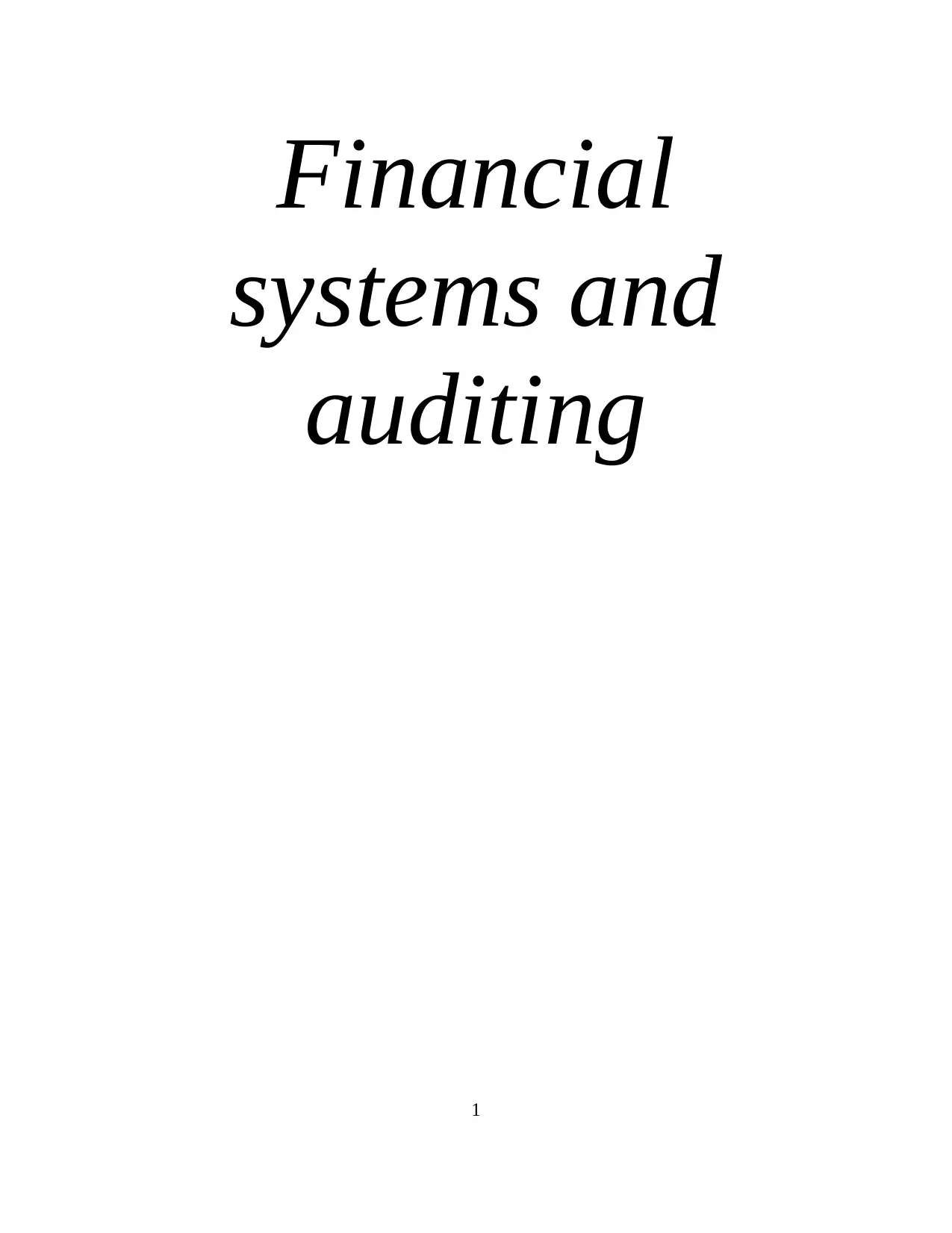
Financial
systems and
auditing
1
systems and
auditing
1
Paraphrase This Document
Need a fresh take? Get an instant paraphrase of this document with our AI Paraphraser
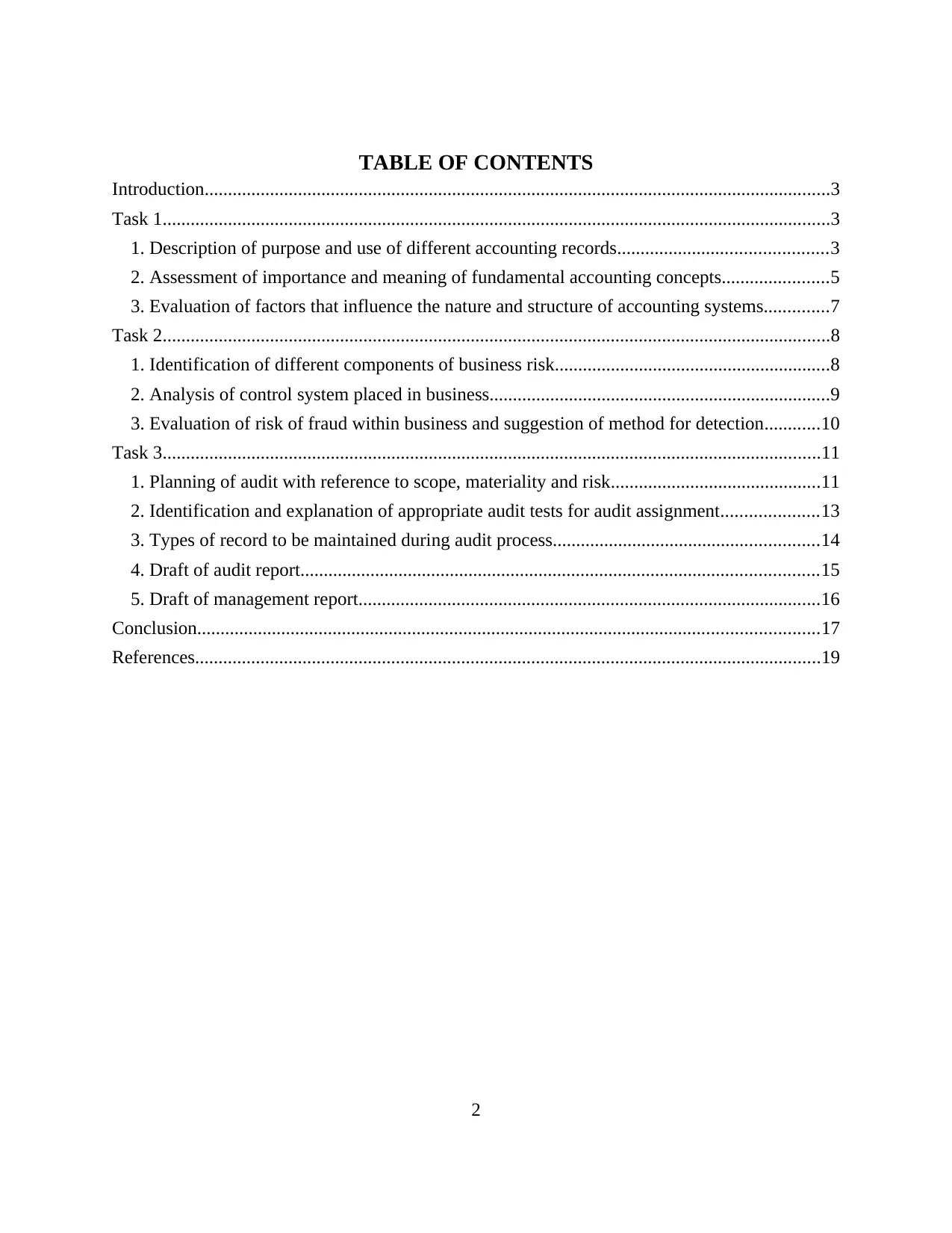
TABLE OF CONTENTS
Introduction......................................................................................................................................3
Task 1...............................................................................................................................................3
1. Description of purpose and use of different accounting records.............................................3
2. Assessment of importance and meaning of fundamental accounting concepts.......................5
3. Evaluation of factors that influence the nature and structure of accounting systems..............7
Task 2...............................................................................................................................................8
1. Identification of different components of business risk...........................................................8
2. Analysis of control system placed in business.........................................................................9
3. Evaluation of risk of fraud within business and suggestion of method for detection............10
Task 3.............................................................................................................................................11
1. Planning of audit with reference to scope, materiality and risk.............................................11
2. Identification and explanation of appropriate audit tests for audit assignment.....................13
3. Types of record to be maintained during audit process.........................................................14
4. Draft of audit report...............................................................................................................15
5. Draft of management report...................................................................................................16
Conclusion.....................................................................................................................................17
References......................................................................................................................................19
2
Introduction......................................................................................................................................3
Task 1...............................................................................................................................................3
1. Description of purpose and use of different accounting records.............................................3
2. Assessment of importance and meaning of fundamental accounting concepts.......................5
3. Evaluation of factors that influence the nature and structure of accounting systems..............7
Task 2...............................................................................................................................................8
1. Identification of different components of business risk...........................................................8
2. Analysis of control system placed in business.........................................................................9
3. Evaluation of risk of fraud within business and suggestion of method for detection............10
Task 3.............................................................................................................................................11
1. Planning of audit with reference to scope, materiality and risk.............................................11
2. Identification and explanation of appropriate audit tests for audit assignment.....................13
3. Types of record to be maintained during audit process.........................................................14
4. Draft of audit report...............................................................................................................15
5. Draft of management report...................................................................................................16
Conclusion.....................................................................................................................................17
References......................................................................................................................................19
2
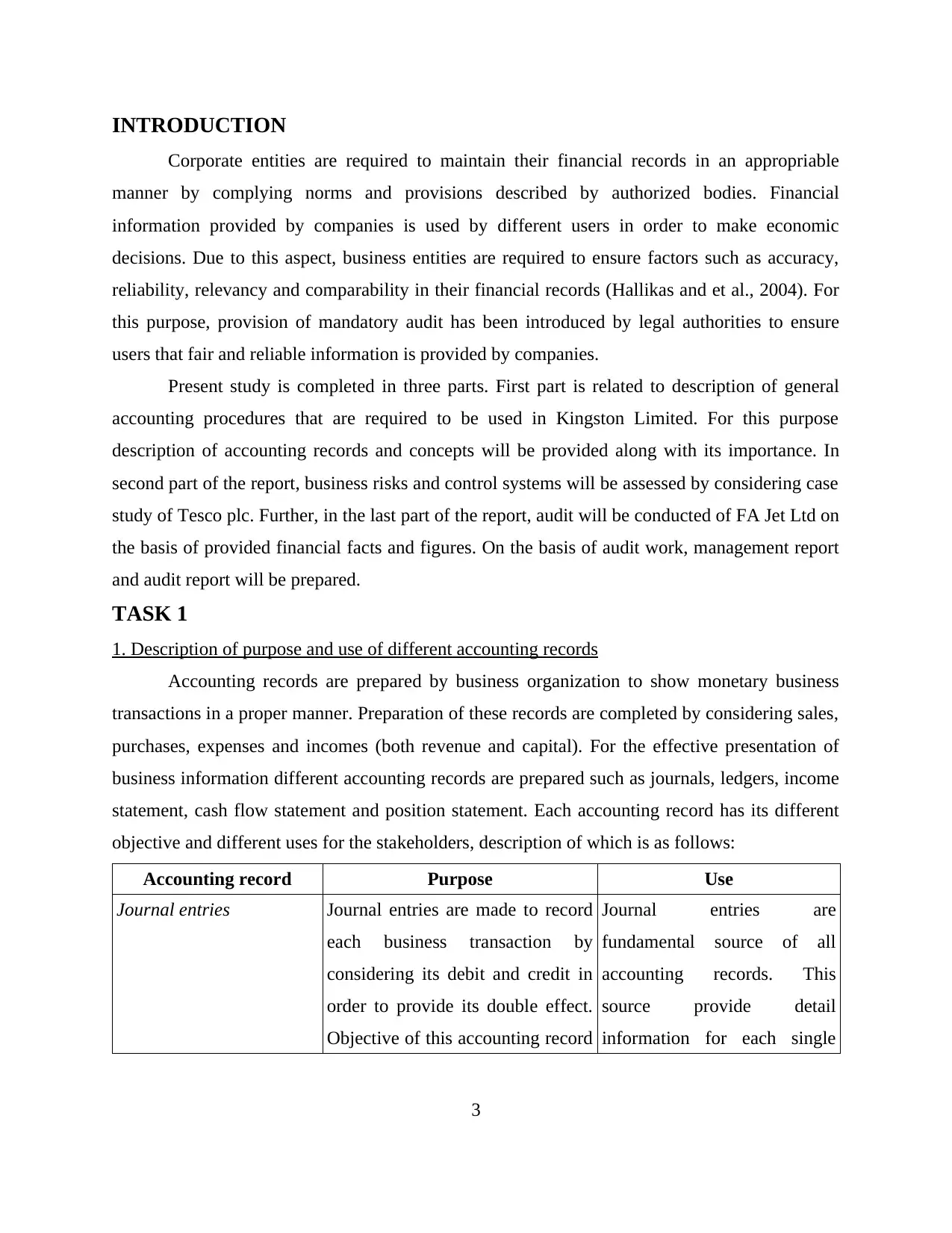
INTRODUCTION
Corporate entities are required to maintain their financial records in an appropriable
manner by complying norms and provisions described by authorized bodies. Financial
information provided by companies is used by different users in order to make economic
decisions. Due to this aspect, business entities are required to ensure factors such as accuracy,
reliability, relevancy and comparability in their financial records (Hallikas and et al., 2004). For
this purpose, provision of mandatory audit has been introduced by legal authorities to ensure
users that fair and reliable information is provided by companies.
Present study is completed in three parts. First part is related to description of general
accounting procedures that are required to be used in Kingston Limited. For this purpose
description of accounting records and concepts will be provided along with its importance. In
second part of the report, business risks and control systems will be assessed by considering case
study of Tesco plc. Further, in the last part of the report, audit will be conducted of FA Jet Ltd on
the basis of provided financial facts and figures. On the basis of audit work, management report
and audit report will be prepared.
TASK 1
1. Description of purpose and use of different accounting records
Accounting records are prepared by business organization to show monetary business
transactions in a proper manner. Preparation of these records are completed by considering sales,
purchases, expenses and incomes (both revenue and capital). For the effective presentation of
business information different accounting records are prepared such as journals, ledgers, income
statement, cash flow statement and position statement. Each accounting record has its different
objective and different uses for the stakeholders, description of which is as follows:
Accounting record Purpose Use
Journal entries Journal entries are made to record
each business transaction by
considering its debit and credit in
order to provide its double effect.
Objective of this accounting record
Journal entries are
fundamental source of all
accounting records. This
source provide detail
information for each single
3
Corporate entities are required to maintain their financial records in an appropriable
manner by complying norms and provisions described by authorized bodies. Financial
information provided by companies is used by different users in order to make economic
decisions. Due to this aspect, business entities are required to ensure factors such as accuracy,
reliability, relevancy and comparability in their financial records (Hallikas and et al., 2004). For
this purpose, provision of mandatory audit has been introduced by legal authorities to ensure
users that fair and reliable information is provided by companies.
Present study is completed in three parts. First part is related to description of general
accounting procedures that are required to be used in Kingston Limited. For this purpose
description of accounting records and concepts will be provided along with its importance. In
second part of the report, business risks and control systems will be assessed by considering case
study of Tesco plc. Further, in the last part of the report, audit will be conducted of FA Jet Ltd on
the basis of provided financial facts and figures. On the basis of audit work, management report
and audit report will be prepared.
TASK 1
1. Description of purpose and use of different accounting records
Accounting records are prepared by business organization to show monetary business
transactions in a proper manner. Preparation of these records are completed by considering sales,
purchases, expenses and incomes (both revenue and capital). For the effective presentation of
business information different accounting records are prepared such as journals, ledgers, income
statement, cash flow statement and position statement. Each accounting record has its different
objective and different uses for the stakeholders, description of which is as follows:
Accounting record Purpose Use
Journal entries Journal entries are made to record
each business transaction by
considering its debit and credit in
order to provide its double effect.
Objective of this accounting record
Journal entries are
fundamental source of all
accounting records. This
source provide detail
information for each single
3
⊘ This is a preview!⊘
Do you want full access?
Subscribe today to unlock all pages.

Trusted by 1+ million students worldwide
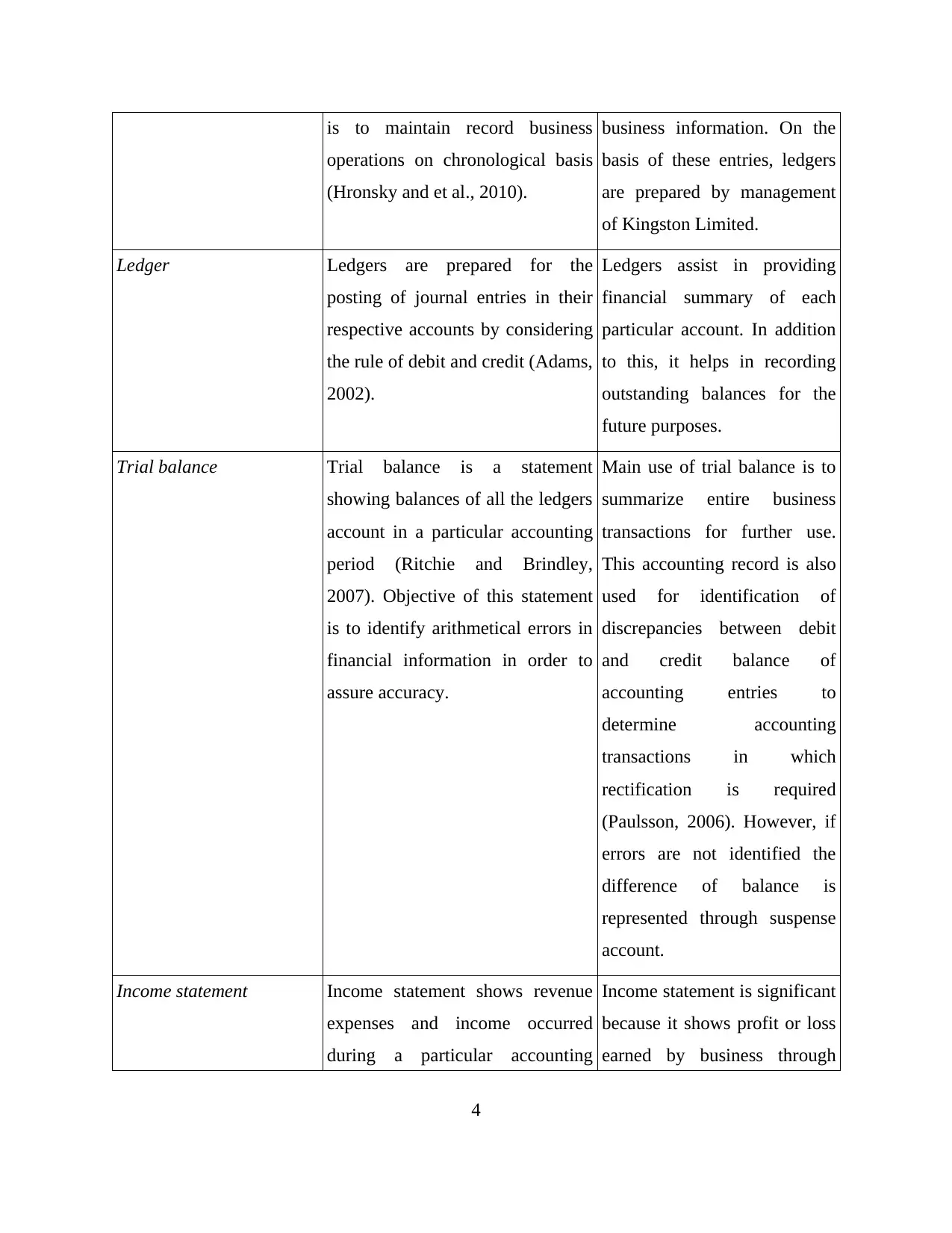
is to maintain record business
operations on chronological basis
(Hronsky and et al., 2010).
business information. On the
basis of these entries, ledgers
are prepared by management
of Kingston Limited.
Ledger Ledgers are prepared for the
posting of journal entries in their
respective accounts by considering
the rule of debit and credit (Adams,
2002).
Ledgers assist in providing
financial summary of each
particular account. In addition
to this, it helps in recording
outstanding balances for the
future purposes.
Trial balance Trial balance is a statement
showing balances of all the ledgers
account in a particular accounting
period (Ritchie and Brindley,
2007). Objective of this statement
is to identify arithmetical errors in
financial information in order to
assure accuracy.
Main use of trial balance is to
summarize entire business
transactions for further use.
This accounting record is also
used for identification of
discrepancies between debit
and credit balance of
accounting entries to
determine accounting
transactions in which
rectification is required
(Paulsson, 2006). However, if
errors are not identified the
difference of balance is
represented through suspense
account.
Income statement Income statement shows revenue
expenses and income occurred
during a particular accounting
Income statement is significant
because it shows profit or loss
earned by business through
4
operations on chronological basis
(Hronsky and et al., 2010).
business information. On the
basis of these entries, ledgers
are prepared by management
of Kingston Limited.
Ledger Ledgers are prepared for the
posting of journal entries in their
respective accounts by considering
the rule of debit and credit (Adams,
2002).
Ledgers assist in providing
financial summary of each
particular account. In addition
to this, it helps in recording
outstanding balances for the
future purposes.
Trial balance Trial balance is a statement
showing balances of all the ledgers
account in a particular accounting
period (Ritchie and Brindley,
2007). Objective of this statement
is to identify arithmetical errors in
financial information in order to
assure accuracy.
Main use of trial balance is to
summarize entire business
transactions for further use.
This accounting record is also
used for identification of
discrepancies between debit
and credit balance of
accounting entries to
determine accounting
transactions in which
rectification is required
(Paulsson, 2006). However, if
errors are not identified the
difference of balance is
represented through suspense
account.
Income statement Income statement shows revenue
expenses and income occurred
during a particular accounting
Income statement is significant
because it shows profit or loss
earned by business through
4
Paraphrase This Document
Need a fresh take? Get an instant paraphrase of this document with our AI Paraphraser
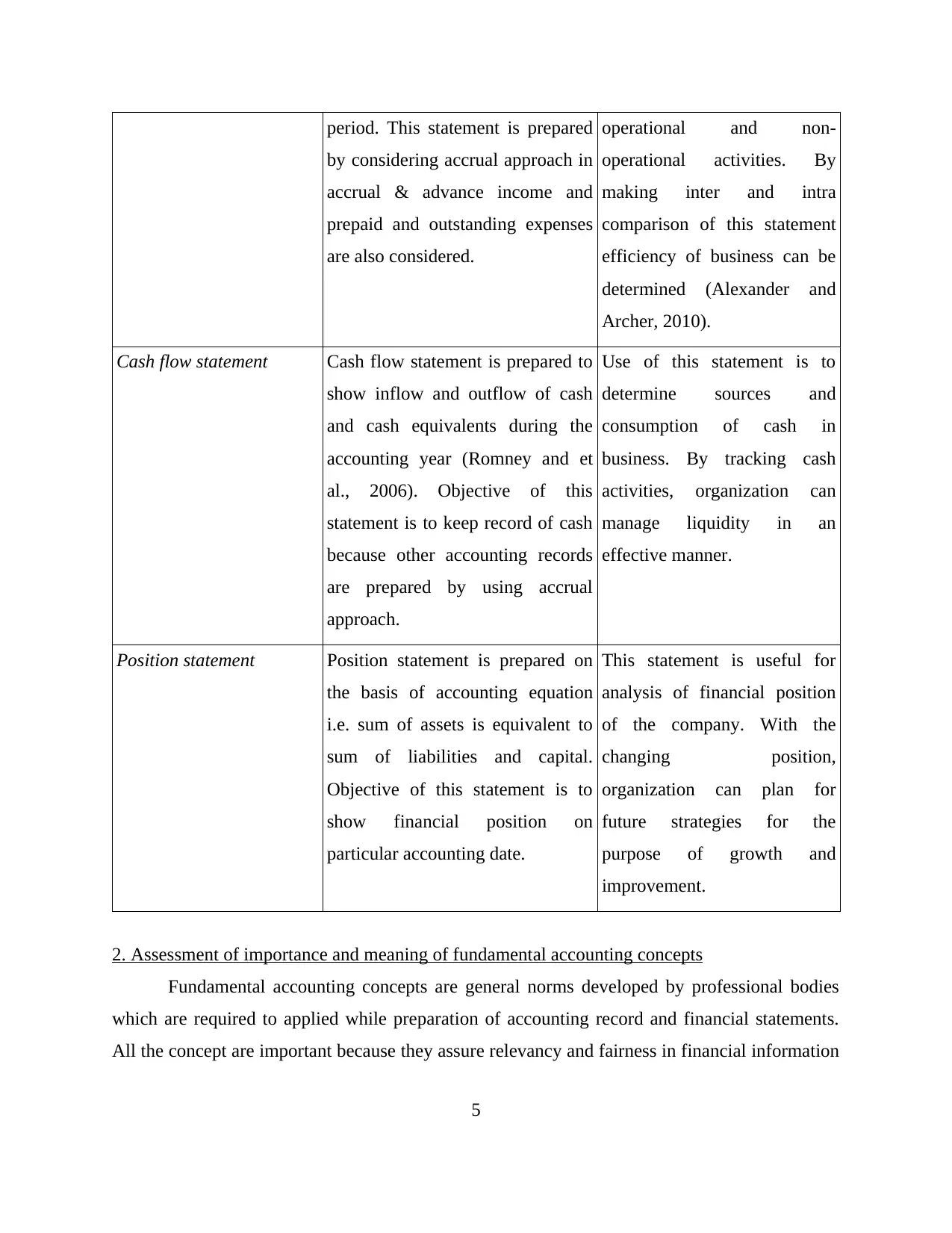
period. This statement is prepared
by considering accrual approach in
accrual & advance income and
prepaid and outstanding expenses
are also considered.
operational and non-
operational activities. By
making inter and intra
comparison of this statement
efficiency of business can be
determined (Alexander and
Archer, 2010).
Cash flow statement Cash flow statement is prepared to
show inflow and outflow of cash
and cash equivalents during the
accounting year (Romney and et
al., 2006). Objective of this
statement is to keep record of cash
because other accounting records
are prepared by using accrual
approach.
Use of this statement is to
determine sources and
consumption of cash in
business. By tracking cash
activities, organization can
manage liquidity in an
effective manner.
Position statement Position statement is prepared on
the basis of accounting equation
i.e. sum of assets is equivalent to
sum of liabilities and capital.
Objective of this statement is to
show financial position on
particular accounting date.
This statement is useful for
analysis of financial position
of the company. With the
changing position,
organization can plan for
future strategies for the
purpose of growth and
improvement.
2. Assessment of importance and meaning of fundamental accounting concepts
Fundamental accounting concepts are general norms developed by professional bodies
which are required to applied while preparation of accounting record and financial statements.
All the concept are important because they assure relevancy and fairness in financial information
5
by considering accrual approach in
accrual & advance income and
prepaid and outstanding expenses
are also considered.
operational and non-
operational activities. By
making inter and intra
comparison of this statement
efficiency of business can be
determined (Alexander and
Archer, 2010).
Cash flow statement Cash flow statement is prepared to
show inflow and outflow of cash
and cash equivalents during the
accounting year (Romney and et
al., 2006). Objective of this
statement is to keep record of cash
because other accounting records
are prepared by using accrual
approach.
Use of this statement is to
determine sources and
consumption of cash in
business. By tracking cash
activities, organization can
manage liquidity in an
effective manner.
Position statement Position statement is prepared on
the basis of accounting equation
i.e. sum of assets is equivalent to
sum of liabilities and capital.
Objective of this statement is to
show financial position on
particular accounting date.
This statement is useful for
analysis of financial position
of the company. With the
changing position,
organization can plan for
future strategies for the
purpose of growth and
improvement.
2. Assessment of importance and meaning of fundamental accounting concepts
Fundamental accounting concepts are general norms developed by professional bodies
which are required to applied while preparation of accounting record and financial statements.
All the concept are important because they assure relevancy and fairness in financial information
5
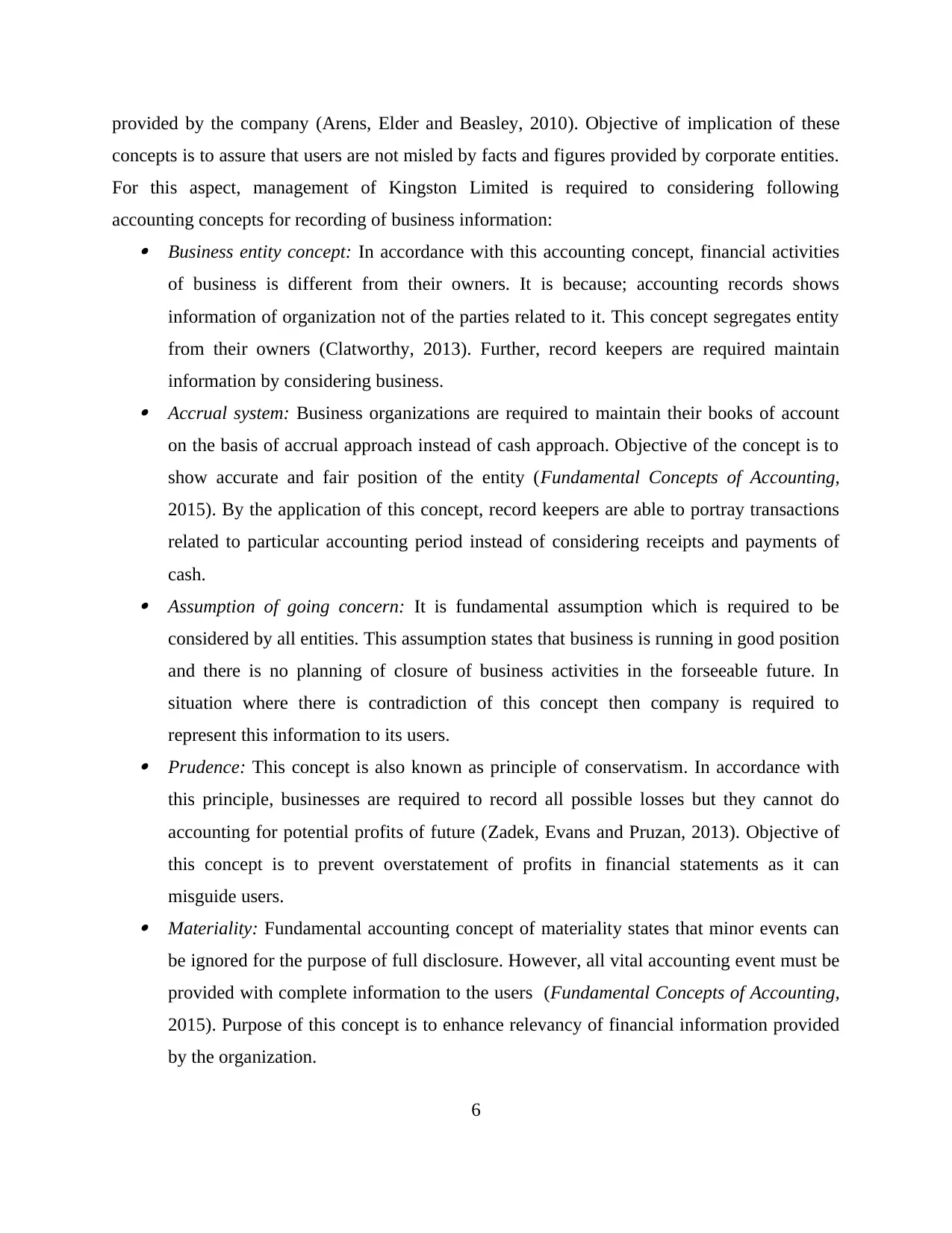
provided by the company (Arens, Elder and Beasley, 2010). Objective of implication of these
concepts is to assure that users are not misled by facts and figures provided by corporate entities.
For this aspect, management of Kingston Limited is required to considering following
accounting concepts for recording of business information: Business entity concept: In accordance with this accounting concept, financial activities
of business is different from their owners. It is because; accounting records shows
information of organization not of the parties related to it. This concept segregates entity
from their owners (Clatworthy, 2013). Further, record keepers are required maintain
information by considering business. Accrual system: Business organizations are required to maintain their books of account
on the basis of accrual approach instead of cash approach. Objective of the concept is to
show accurate and fair position of the entity (Fundamental Concepts of Accounting,
2015). By the application of this concept, record keepers are able to portray transactions
related to particular accounting period instead of considering receipts and payments of
cash. Assumption of going concern: It is fundamental assumption which is required to be
considered by all entities. This assumption states that business is running in good position
and there is no planning of closure of business activities in the forseeable future. In
situation where there is contradiction of this concept then company is required to
represent this information to its users. Prudence: This concept is also known as principle of conservatism. In accordance with
this principle, businesses are required to record all possible losses but they cannot do
accounting for potential profits of future (Zadek, Evans and Pruzan, 2013). Objective of
this concept is to prevent overstatement of profits in financial statements as it can
misguide users. Materiality: Fundamental accounting concept of materiality states that minor events can
be ignored for the purpose of full disclosure. However, all vital accounting event must be
provided with complete information to the users (Fundamental Concepts of Accounting,
2015). Purpose of this concept is to enhance relevancy of financial information provided
by the organization.
6
concepts is to assure that users are not misled by facts and figures provided by corporate entities.
For this aspect, management of Kingston Limited is required to considering following
accounting concepts for recording of business information: Business entity concept: In accordance with this accounting concept, financial activities
of business is different from their owners. It is because; accounting records shows
information of organization not of the parties related to it. This concept segregates entity
from their owners (Clatworthy, 2013). Further, record keepers are required maintain
information by considering business. Accrual system: Business organizations are required to maintain their books of account
on the basis of accrual approach instead of cash approach. Objective of the concept is to
show accurate and fair position of the entity (Fundamental Concepts of Accounting,
2015). By the application of this concept, record keepers are able to portray transactions
related to particular accounting period instead of considering receipts and payments of
cash. Assumption of going concern: It is fundamental assumption which is required to be
considered by all entities. This assumption states that business is running in good position
and there is no planning of closure of business activities in the forseeable future. In
situation where there is contradiction of this concept then company is required to
represent this information to its users. Prudence: This concept is also known as principle of conservatism. In accordance with
this principle, businesses are required to record all possible losses but they cannot do
accounting for potential profits of future (Zadek, Evans and Pruzan, 2013). Objective of
this concept is to prevent overstatement of profits in financial statements as it can
misguide users. Materiality: Fundamental accounting concept of materiality states that minor events can
be ignored for the purpose of full disclosure. However, all vital accounting event must be
provided with complete information to the users (Fundamental Concepts of Accounting,
2015). Purpose of this concept is to enhance relevancy of financial information provided
by the organization.
6
⊘ This is a preview!⊘
Do you want full access?
Subscribe today to unlock all pages.

Trusted by 1+ million students worldwide
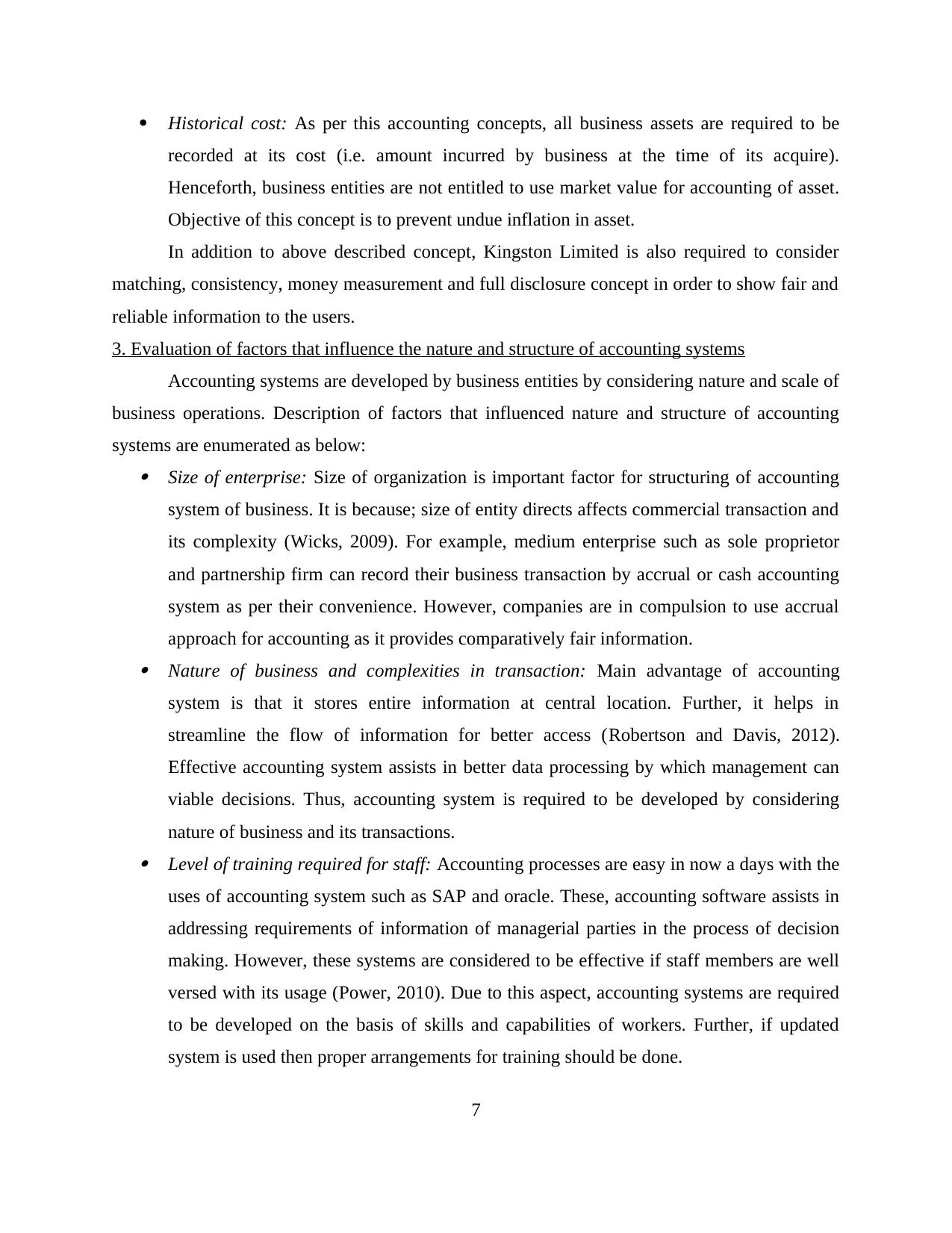
Historical cost: As per this accounting concepts, all business assets are required to be
recorded at its cost (i.e. amount incurred by business at the time of its acquire).
Henceforth, business entities are not entitled to use market value for accounting of asset.
Objective of this concept is to prevent undue inflation in asset.
In addition to above described concept, Kingston Limited is also required to consider
matching, consistency, money measurement and full disclosure concept in order to show fair and
reliable information to the users.
3. Evaluation of factors that influence the nature and structure of accounting systems
Accounting systems are developed by business entities by considering nature and scale of
business operations. Description of factors that influenced nature and structure of accounting
systems are enumerated as below: Size of enterprise: Size of organization is important factor for structuring of accounting
system of business. It is because; size of entity directs affects commercial transaction and
its complexity (Wicks, 2009). For example, medium enterprise such as sole proprietor
and partnership firm can record their business transaction by accrual or cash accounting
system as per their convenience. However, companies are in compulsion to use accrual
approach for accounting as it provides comparatively fair information. Nature of business and complexities in transaction: Main advantage of accounting
system is that it stores entire information at central location. Further, it helps in
streamline the flow of information for better access (Robertson and Davis, 2012).
Effective accounting system assists in better data processing by which management can
viable decisions. Thus, accounting system is required to be developed by considering
nature of business and its transactions. Level of training required for staff: Accounting processes are easy in now a days with the
uses of accounting system such as SAP and oracle. These, accounting software assists in
addressing requirements of information of managerial parties in the process of decision
making. However, these systems are considered to be effective if staff members are well
versed with its usage (Power, 2010). Due to this aspect, accounting systems are required
to be developed on the basis of skills and capabilities of workers. Further, if updated
system is used then proper arrangements for training should be done.
7
recorded at its cost (i.e. amount incurred by business at the time of its acquire).
Henceforth, business entities are not entitled to use market value for accounting of asset.
Objective of this concept is to prevent undue inflation in asset.
In addition to above described concept, Kingston Limited is also required to consider
matching, consistency, money measurement and full disclosure concept in order to show fair and
reliable information to the users.
3. Evaluation of factors that influence the nature and structure of accounting systems
Accounting systems are developed by business entities by considering nature and scale of
business operations. Description of factors that influenced nature and structure of accounting
systems are enumerated as below: Size of enterprise: Size of organization is important factor for structuring of accounting
system of business. It is because; size of entity directs affects commercial transaction and
its complexity (Wicks, 2009). For example, medium enterprise such as sole proprietor
and partnership firm can record their business transaction by accrual or cash accounting
system as per their convenience. However, companies are in compulsion to use accrual
approach for accounting as it provides comparatively fair information. Nature of business and complexities in transaction: Main advantage of accounting
system is that it stores entire information at central location. Further, it helps in
streamline the flow of information for better access (Robertson and Davis, 2012).
Effective accounting system assists in better data processing by which management can
viable decisions. Thus, accounting system is required to be developed by considering
nature of business and its transactions. Level of training required for staff: Accounting processes are easy in now a days with the
uses of accounting system such as SAP and oracle. These, accounting software assists in
addressing requirements of information of managerial parties in the process of decision
making. However, these systems are considered to be effective if staff members are well
versed with its usage (Power, 2010). Due to this aspect, accounting systems are required
to be developed on the basis of skills and capabilities of workers. Further, if updated
system is used then proper arrangements for training should be done.
7
Paraphrase This Document
Need a fresh take? Get an instant paraphrase of this document with our AI Paraphraser

Service provider differentiator: This factor is required to be considered for alignment of
IT strategy with the organizational strategy. Each services provider has its own pros and
cons. It is because; customized systems are not only costly because they are also time
consuming for implementation (No, 2007). Thus, business entity is required to consider
financial impact and potential benefits and along with the costs of using IT services.
System Cost: Organizations are also required to consider the cost of accounting system in
order to assure its financial feasibility. It is because; various accounting software have
cost in millions of dollars which is not affordable by all organization due to which they
are required to general software as per their needs.
TASK 2
1. Identification of different components of business risk
All corporate entities are required to bear risk while commencing their business
operational. However, extent of business risks varies with the nature and scale of operations. For
the survival and long term success, commercial entities are required to mitigate these risks
(Power, 2010). In present era, companies are exposed to several risk components that can have
adverse impact on their profitability, productivity and market reputation. By considering the case
study of Tesco, description of component of business risks is as follows: Risk related to human resources: It is general risk faced by all business organization.
Increasing employee turnover is not a good factor for business because it enhances cost
of recruitment and training (Nelson, 2009). In addition to this, business has to loss
skilled, qualified and experienced employees from the work place. This risk has severe
impact on the productivity of business. Technological risk: Entire operational activities of Tesco are aligned through
information technology. Due to this aspect, single error or issue in technology can have
severe adverse impact on their operational activities. Major influence of this risk is on
their online segment in which each task is completed by use of integrated technology
systems. Regulatory risk:All commercial entities are required to comply legal provisions and
political guidelines in their operational policies and procedures. In situation where they
failed to do so, then they have to pay high penalties (Robertson and Davis, 2012). In
8
IT strategy with the organizational strategy. Each services provider has its own pros and
cons. It is because; customized systems are not only costly because they are also time
consuming for implementation (No, 2007). Thus, business entity is required to consider
financial impact and potential benefits and along with the costs of using IT services.
System Cost: Organizations are also required to consider the cost of accounting system in
order to assure its financial feasibility. It is because; various accounting software have
cost in millions of dollars which is not affordable by all organization due to which they
are required to general software as per their needs.
TASK 2
1. Identification of different components of business risk
All corporate entities are required to bear risk while commencing their business
operational. However, extent of business risks varies with the nature and scale of operations. For
the survival and long term success, commercial entities are required to mitigate these risks
(Power, 2010). In present era, companies are exposed to several risk components that can have
adverse impact on their profitability, productivity and market reputation. By considering the case
study of Tesco, description of component of business risks is as follows: Risk related to human resources: It is general risk faced by all business organization.
Increasing employee turnover is not a good factor for business because it enhances cost
of recruitment and training (Nelson, 2009). In addition to this, business has to loss
skilled, qualified and experienced employees from the work place. This risk has severe
impact on the productivity of business. Technological risk: Entire operational activities of Tesco are aligned through
information technology. Due to this aspect, single error or issue in technology can have
severe adverse impact on their operational activities. Major influence of this risk is on
their online segment in which each task is completed by use of integrated technology
systems. Regulatory risk:All commercial entities are required to comply legal provisions and
political guidelines in their operational policies and procedures. In situation where they
failed to do so, then they have to pay high penalties (Robertson and Davis, 2012). In
8
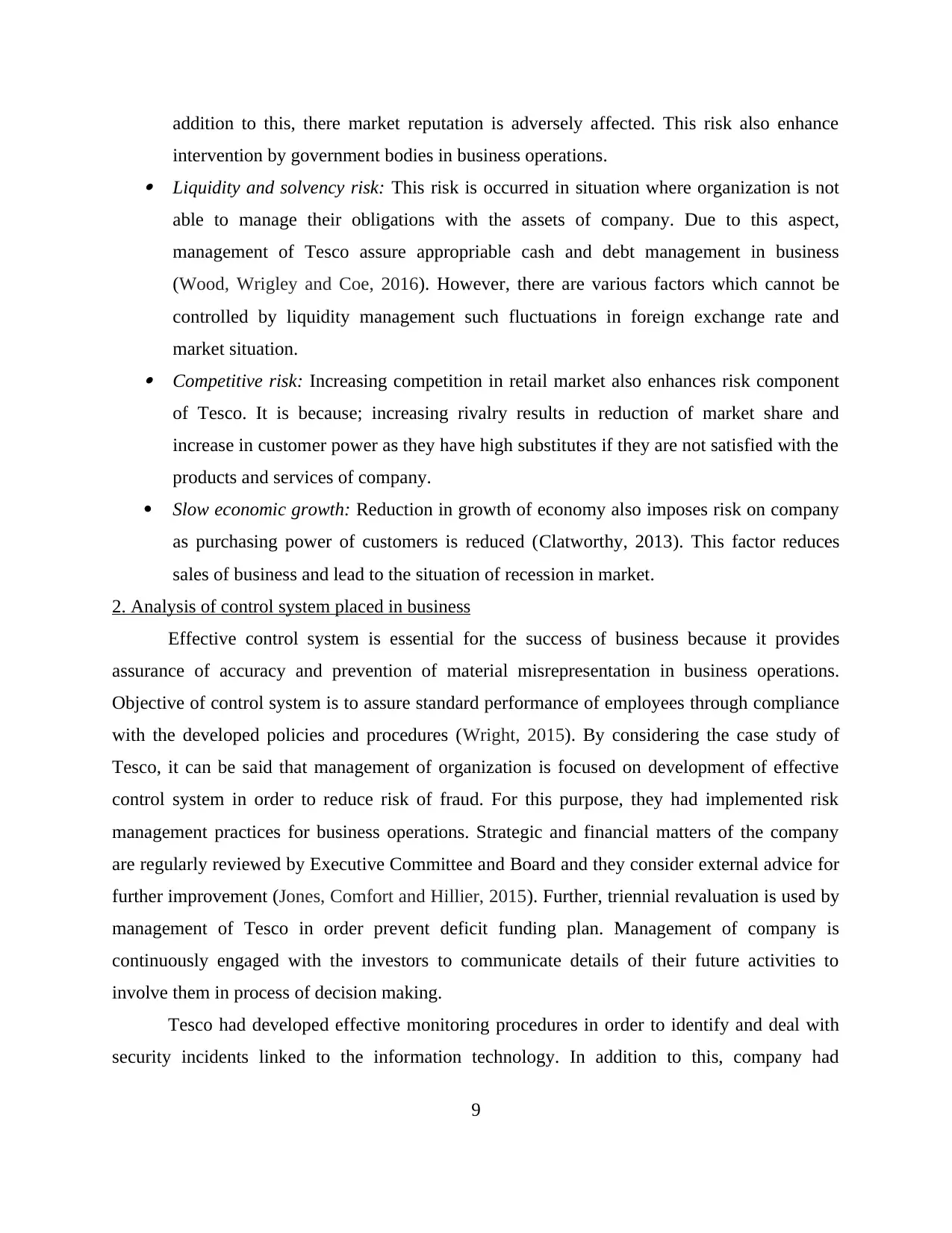
addition to this, there market reputation is adversely affected. This risk also enhance
intervention by government bodies in business operations. Liquidity and solvency risk: This risk is occurred in situation where organization is not
able to manage their obligations with the assets of company. Due to this aspect,
management of Tesco assure appropriable cash and debt management in business
(Wood, Wrigley and Coe, 2016). However, there are various factors which cannot be
controlled by liquidity management such fluctuations in foreign exchange rate and
market situation. Competitive risk: Increasing competition in retail market also enhances risk component
of Tesco. It is because; increasing rivalry results in reduction of market share and
increase in customer power as they have high substitutes if they are not satisfied with the
products and services of company.
Slow economic growth: Reduction in growth of economy also imposes risk on company
as purchasing power of customers is reduced (Clatworthy, 2013). This factor reduces
sales of business and lead to the situation of recession in market.
2. Analysis of control system placed in business
Effective control system is essential for the success of business because it provides
assurance of accuracy and prevention of material misrepresentation in business operations.
Objective of control system is to assure standard performance of employees through compliance
with the developed policies and procedures (Wright, 2015). By considering the case study of
Tesco, it can be said that management of organization is focused on development of effective
control system in order to reduce risk of fraud. For this purpose, they had implemented risk
management practices for business operations. Strategic and financial matters of the company
are regularly reviewed by Executive Committee and Board and they consider external advice for
further improvement (Jones, Comfort and Hillier, 2015). Further, triennial revaluation is used by
management of Tesco in order prevent deficit funding plan. Management of company is
continuously engaged with the investors to communicate details of their future activities to
involve them in process of decision making.
Tesco had developed effective monitoring procedures in order to identify and deal with
security incidents linked to the information technology. In addition to this, company had
9
intervention by government bodies in business operations. Liquidity and solvency risk: This risk is occurred in situation where organization is not
able to manage their obligations with the assets of company. Due to this aspect,
management of Tesco assure appropriable cash and debt management in business
(Wood, Wrigley and Coe, 2016). However, there are various factors which cannot be
controlled by liquidity management such fluctuations in foreign exchange rate and
market situation. Competitive risk: Increasing competition in retail market also enhances risk component
of Tesco. It is because; increasing rivalry results in reduction of market share and
increase in customer power as they have high substitutes if they are not satisfied with the
products and services of company.
Slow economic growth: Reduction in growth of economy also imposes risk on company
as purchasing power of customers is reduced (Clatworthy, 2013). This factor reduces
sales of business and lead to the situation of recession in market.
2. Analysis of control system placed in business
Effective control system is essential for the success of business because it provides
assurance of accuracy and prevention of material misrepresentation in business operations.
Objective of control system is to assure standard performance of employees through compliance
with the developed policies and procedures (Wright, 2015). By considering the case study of
Tesco, it can be said that management of organization is focused on development of effective
control system in order to reduce risk of fraud. For this purpose, they had implemented risk
management practices for business operations. Strategic and financial matters of the company
are regularly reviewed by Executive Committee and Board and they consider external advice for
further improvement (Jones, Comfort and Hillier, 2015). Further, triennial revaluation is used by
management of Tesco in order prevent deficit funding plan. Management of company is
continuously engaged with the investors to communicate details of their future activities to
involve them in process of decision making.
Tesco had developed effective monitoring procedures in order to identify and deal with
security incidents linked to the information technology. In addition to this, company had
9
⊘ This is a preview!⊘
Do you want full access?
Subscribe today to unlock all pages.

Trusted by 1+ million students worldwide

developed Cyber Security team in order to mitigate the risks of cyber attacks. Executive
committee of the company also ensures performance risks by considering their targets based on
their new balanced scorecard of performance against KPIs and financial targets. Furthermore,
appropriable controls are place in processes such as product development, supplier management,
compliance with legal provisions and distribution of standards (Schroeder and Shepardson,
2016). For the prevention of financial frauds, dual control system is place in the business. This
system ensures that physical recording and book keeping task is not allocated to the similar
person. With the approach, comparison can be made in both the task for the purpose of
identification of discrepancies. Mainly this approach is applicable for management of cash and
Inventory in Tesco. By considering this approach, purchase of materials are processed by store
department and accounting records of purchase are managed by finance department. Similarly,
physical cash is maintained with treasures and accounting records are kept by finance
department. On the periodical basis, these balances are compared and appropriable actions are
taken for material differences.
3. Evaluation of risk of fraud within business and suggestion of method for detection
Fraud can be defined as deliberate activity conducted by individual from the objective to
deceive another individual. It is not essential that all business frauds have impact on financial
statement of company.
Overstatement of revenue
On the basis of annual report of Tesco, it can be noticed that major risk arises from the
supplier activities and excessive involvement of managerial persons in operational activities.
Annual report of company shows that, recently they had faced severe accounting scandal
regarding overstatement of profits. These misstatements were stated by considering rebate
provided by the suppliers in previous accounting period as profit of current accounting period
(Singh, 2015). In this aspect, directors have commented that this error is occurred by junior
employees of financial department.
For the prevention of such risks of fraud, management of Tesco can make use of IT tools
such as data mining. By making use of this tool, organization can detect accounting errors in an
effective manner. Furthermore, supervisors can monitor the work of subordinates to ensure that
correct accounting principles are followed by them in recording business transactions.
10
committee of the company also ensures performance risks by considering their targets based on
their new balanced scorecard of performance against KPIs and financial targets. Furthermore,
appropriable controls are place in processes such as product development, supplier management,
compliance with legal provisions and distribution of standards (Schroeder and Shepardson,
2016). For the prevention of financial frauds, dual control system is place in the business. This
system ensures that physical recording and book keeping task is not allocated to the similar
person. With the approach, comparison can be made in both the task for the purpose of
identification of discrepancies. Mainly this approach is applicable for management of cash and
Inventory in Tesco. By considering this approach, purchase of materials are processed by store
department and accounting records of purchase are managed by finance department. Similarly,
physical cash is maintained with treasures and accounting records are kept by finance
department. On the periodical basis, these balances are compared and appropriable actions are
taken for material differences.
3. Evaluation of risk of fraud within business and suggestion of method for detection
Fraud can be defined as deliberate activity conducted by individual from the objective to
deceive another individual. It is not essential that all business frauds have impact on financial
statement of company.
Overstatement of revenue
On the basis of annual report of Tesco, it can be noticed that major risk arises from the
supplier activities and excessive involvement of managerial persons in operational activities.
Annual report of company shows that, recently they had faced severe accounting scandal
regarding overstatement of profits. These misstatements were stated by considering rebate
provided by the suppliers in previous accounting period as profit of current accounting period
(Singh, 2015). In this aspect, directors have commented that this error is occurred by junior
employees of financial department.
For the prevention of such risks of fraud, management of Tesco can make use of IT tools
such as data mining. By making use of this tool, organization can detect accounting errors in an
effective manner. Furthermore, supervisors can monitor the work of subordinates to ensure that
correct accounting principles are followed by them in recording business transactions.
10
Paraphrase This Document
Need a fresh take? Get an instant paraphrase of this document with our AI Paraphraser
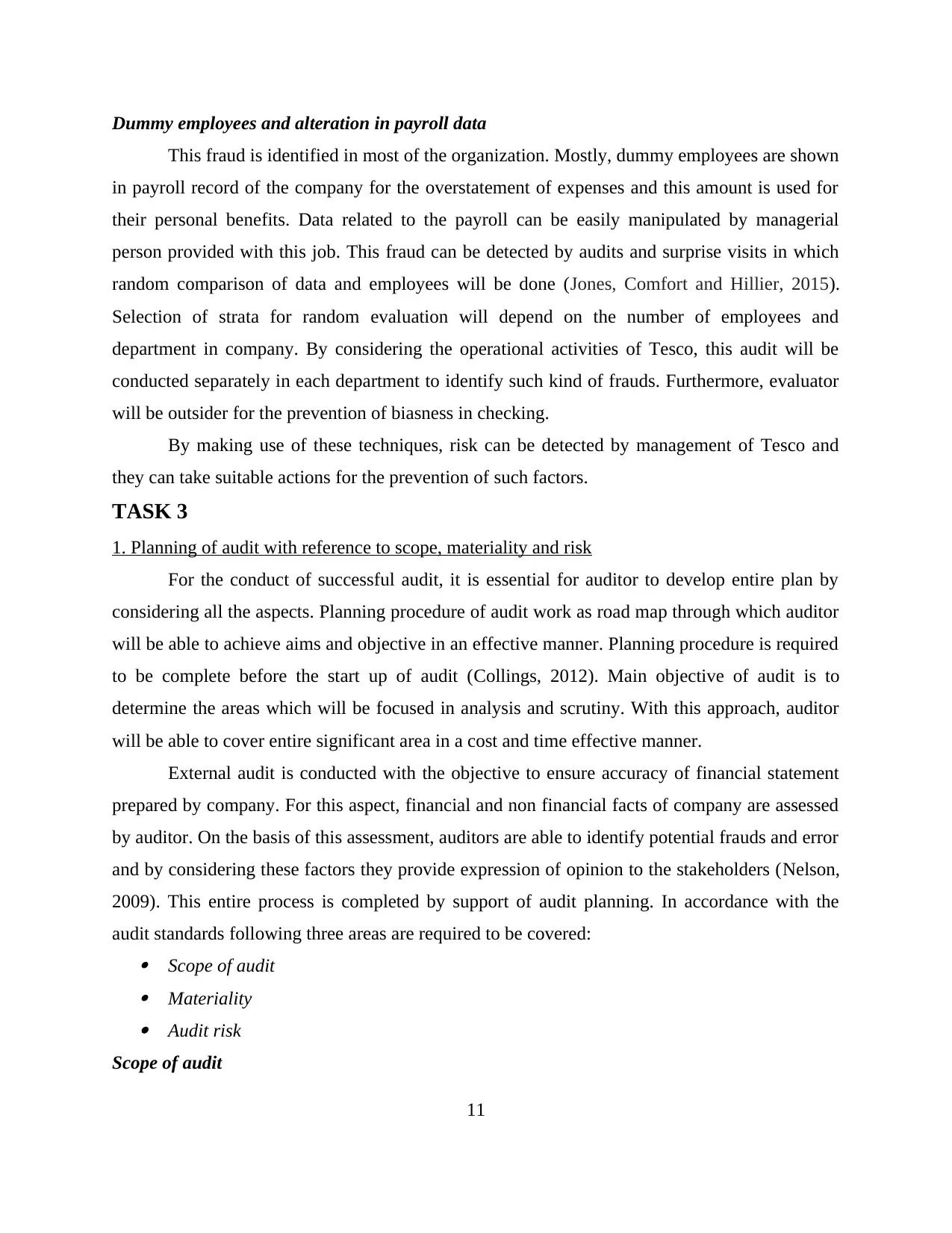
Dummy employees and alteration in payroll data
This fraud is identified in most of the organization. Mostly, dummy employees are shown
in payroll record of the company for the overstatement of expenses and this amount is used for
their personal benefits. Data related to the payroll can be easily manipulated by managerial
person provided with this job. This fraud can be detected by audits and surprise visits in which
random comparison of data and employees will be done (Jones, Comfort and Hillier, 2015).
Selection of strata for random evaluation will depend on the number of employees and
department in company. By considering the operational activities of Tesco, this audit will be
conducted separately in each department to identify such kind of frauds. Furthermore, evaluator
will be outsider for the prevention of biasness in checking.
By making use of these techniques, risk can be detected by management of Tesco and
they can take suitable actions for the prevention of such factors.
TASK 3
1. Planning of audit with reference to scope, materiality and risk
For the conduct of successful audit, it is essential for auditor to develop entire plan by
considering all the aspects. Planning procedure of audit work as road map through which auditor
will be able to achieve aims and objective in an effective manner. Planning procedure is required
to be complete before the start up of audit (Collings, 2012). Main objective of audit is to
determine the areas which will be focused in analysis and scrutiny. With this approach, auditor
will be able to cover entire significant area in a cost and time effective manner.
External audit is conducted with the objective to ensure accuracy of financial statement
prepared by company. For this aspect, financial and non financial facts of company are assessed
by auditor. On the basis of this assessment, auditors are able to identify potential frauds and error
and by considering these factors they provide expression of opinion to the stakeholders (Nelson,
2009). This entire process is completed by support of audit planning. In accordance with the
audit standards following three areas are required to be covered: Scope of audit Materiality Audit risk
Scope of audit
11
This fraud is identified in most of the organization. Mostly, dummy employees are shown
in payroll record of the company for the overstatement of expenses and this amount is used for
their personal benefits. Data related to the payroll can be easily manipulated by managerial
person provided with this job. This fraud can be detected by audits and surprise visits in which
random comparison of data and employees will be done (Jones, Comfort and Hillier, 2015).
Selection of strata for random evaluation will depend on the number of employees and
department in company. By considering the operational activities of Tesco, this audit will be
conducted separately in each department to identify such kind of frauds. Furthermore, evaluator
will be outsider for the prevention of biasness in checking.
By making use of these techniques, risk can be detected by management of Tesco and
they can take suitable actions for the prevention of such factors.
TASK 3
1. Planning of audit with reference to scope, materiality and risk
For the conduct of successful audit, it is essential for auditor to develop entire plan by
considering all the aspects. Planning procedure of audit work as road map through which auditor
will be able to achieve aims and objective in an effective manner. Planning procedure is required
to be complete before the start up of audit (Collings, 2012). Main objective of audit is to
determine the areas which will be focused in analysis and scrutiny. With this approach, auditor
will be able to cover entire significant area in a cost and time effective manner.
External audit is conducted with the objective to ensure accuracy of financial statement
prepared by company. For this aspect, financial and non financial facts of company are assessed
by auditor. On the basis of this assessment, auditors are able to identify potential frauds and error
and by considering these factors they provide expression of opinion to the stakeholders (Nelson,
2009). This entire process is completed by support of audit planning. In accordance with the
audit standards following three areas are required to be covered: Scope of audit Materiality Audit risk
Scope of audit
11

Audit scope can be defined as documents and amount of time involved in the procedure
of auditing. This scope depicts the extent to which in-depth analysis will be conducted. Scope of
present audit is to make assessment of corporate governance regarding risk of fraud and internal
control. On the basis of this assessment, opinion will be provided by auditor regarding fairness of
financial information.
In order to achieve this objective, auditor of FA Jet Ltd will evaluate financial statement
and other relevant information to identify frauds and clerical errors. Evaluation of data will be
done on the basis of random sampling in order to prevent biasness (Ismail, Ibrahim and Isa,
2006). In addition to this, meeting will be conducted with the directors who have resigned from
their posts to determine actual reason and their viewpoint regarding performance of company.
Materiality
Materiality is important factor to be considered in audit in order to enhance its reliability
and validity. In audit, materiality is a measure used for estimation of accuracy of financial
information provided by the company. Generally, all commercial information is not equally
information because of its nature and impact on economic decisions (Robertson and Davis,
2012). Due to this aspect, auditors are required to consider all significant aspects in their audit in
detail and remaining factors can be overviewed. With this approach, they will be cover the
significant aspects for detail assessment in order to achieve objectives of audit in an effective
manner. In present audit, main focus of auditor will be on effectiveness of internal control
system and accuracy of financial information provided.
Audit risk
Audit risk can be defined as probability that appointed auditor will be able to identify
errors and frauds in their assessment procedure or not. Audit risk is determined by auditor on the
basis of internal control system and possibility of inherent risk. It is because; effective internal
control reduces the possibilities of error (Nelson, 2009). Further, inherent risk cannot be
controlled or identified by the auditor if this risk is high then auditor is required to keep audit low
for the purpose of mitigation. In accordance with the provided case scenario, directors are
involved in entire department as there is high possibility of material misstatement. By
considering this aspect, auditor will ensure lower risk for the fair assessment.
12
of auditing. This scope depicts the extent to which in-depth analysis will be conducted. Scope of
present audit is to make assessment of corporate governance regarding risk of fraud and internal
control. On the basis of this assessment, opinion will be provided by auditor regarding fairness of
financial information.
In order to achieve this objective, auditor of FA Jet Ltd will evaluate financial statement
and other relevant information to identify frauds and clerical errors. Evaluation of data will be
done on the basis of random sampling in order to prevent biasness (Ismail, Ibrahim and Isa,
2006). In addition to this, meeting will be conducted with the directors who have resigned from
their posts to determine actual reason and their viewpoint regarding performance of company.
Materiality
Materiality is important factor to be considered in audit in order to enhance its reliability
and validity. In audit, materiality is a measure used for estimation of accuracy of financial
information provided by the company. Generally, all commercial information is not equally
information because of its nature and impact on economic decisions (Robertson and Davis,
2012). Due to this aspect, auditors are required to consider all significant aspects in their audit in
detail and remaining factors can be overviewed. With this approach, they will be cover the
significant aspects for detail assessment in order to achieve objectives of audit in an effective
manner. In present audit, main focus of auditor will be on effectiveness of internal control
system and accuracy of financial information provided.
Audit risk
Audit risk can be defined as probability that appointed auditor will be able to identify
errors and frauds in their assessment procedure or not. Audit risk is determined by auditor on the
basis of internal control system and possibility of inherent risk. It is because; effective internal
control reduces the possibilities of error (Nelson, 2009). Further, inherent risk cannot be
controlled or identified by the auditor if this risk is high then auditor is required to keep audit low
for the purpose of mitigation. In accordance with the provided case scenario, directors are
involved in entire department as there is high possibility of material misstatement. By
considering this aspect, auditor will ensure lower risk for the fair assessment.
12
⊘ This is a preview!⊘
Do you want full access?
Subscribe today to unlock all pages.

Trusted by 1+ million students worldwide
1 out of 21
Related Documents
Your All-in-One AI-Powered Toolkit for Academic Success.
+13062052269
info@desklib.com
Available 24*7 on WhatsApp / Email
![[object Object]](/_next/static/media/star-bottom.7253800d.svg)
Unlock your academic potential
Copyright © 2020–2025 A2Z Services. All Rights Reserved. Developed and managed by ZUCOL.





